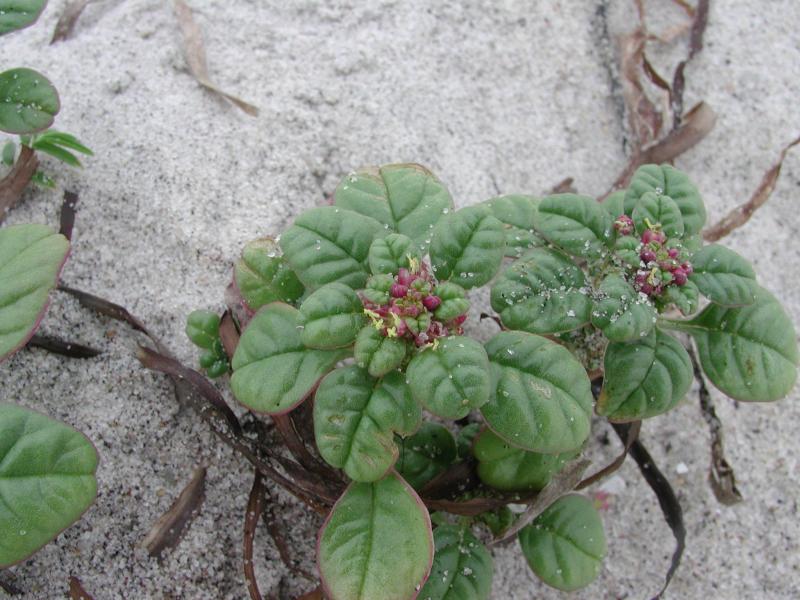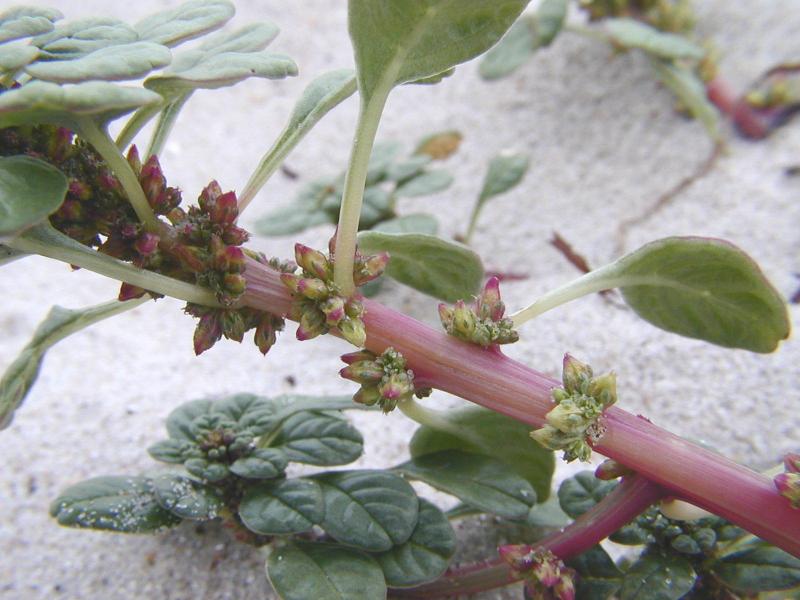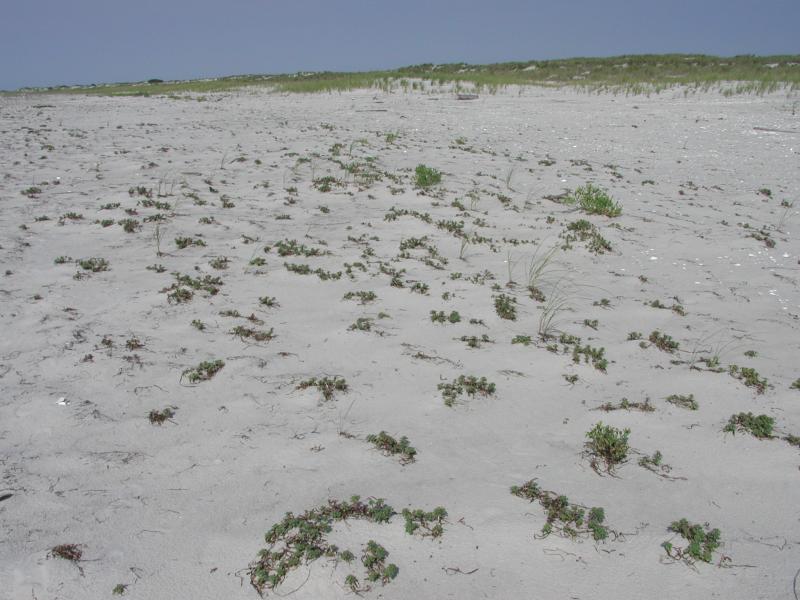Seabeach Amaranth
Amaranthus pumilus Raf.
- Class
- Dicotyledoneae (Dicots)
- Family
- Amaranthaceae (Amaranth Family)
- State Protection
- Threatened
Listed as Threatened by New York State: likely to become Endangered in the foreseeable future. For animals, taking, importation, transportation, or possession is prohibited, except under license or permit. For plants, removal or damage without the consent of the landowner is prohibited.
- Federal Protection
- Threatened
Listed as Threatened under the Federal Endangered Species Act
- State Conservation Status Rank
- S2
Imperiled in New York - Very vulnerable to disappearing from New York due to rarity or other factors; typically 6 to 20 populations or locations in New York, very few individuals, very restricted range, few remaining acres (or miles of stream), and/or steep declines.
- Global Conservation Status Rank
- G2
Imperiled globally - At high risk of extinction due to rarity or other factors; typically 20 or fewer populations or locations in the world, very few individuals, very restricted range, few remaining acres (or miles of stream), and/or steep declines.
Summary
Did you know?
There was a 40-year stretch, between 1950 and 1990, when no plants were documented from the beaches on Long Island. Replenishment of the beaches and better protection of the vegetation through bird fencing may have permitted the species to recover.
State Ranking Justification
There are nine large occurrences of seabeach amaranth, usually encompassing large barrier islands. Occurrences are separated by ocean inlets or by large stretches of highly-developed beach that are inhospitable to the plants. Extensive searches of all Long Island beaches have not found additional populations.
Short-term Trends
In the last 20 years numbers have fluctuated between hundreds of plants to hundreds of thousands of plants islandwide. Numbers peaked in 2002 and have slowly declined.
Long-term Trends
With continued protection and management, the number of plants will probably stabilize in the thousands or even tens of thousands.
Conservation and Management
Threats
The plants are subject to the natural threats of storm damage and succession by beachgrasses. Humans threaten the plants by driving over them with vehicles, beach raking, and by trampling them.
Conservation Strategies and Management Practices
Seabeach amaranth needs wide natural beaches free from vehicle use and excessive trampling. The use of string fencing provides enough protection to enable it to germinate and produce fruit.
Research Needs
There are a number of research needs to understand its distribution, germination and growth, and interaction with its environment.
Habitat
Habitat
The plants occur on barrier island beaches between the foredune and the wrack line and also on open overwash areas behind the foredune. Beaches are usually over 20 meters wide and protected from foot traffic and vehicles (Steve Young, pers. obs.). Sea beaches (Fernald 1970). Sea-beaches (Gleason and Cronquist 1991).
Associated Ecological Communities
- Maritime beach
(guide)
A community with extremely sparse vegetation that occurs on unstable sand, gravel, or cobble ocean shores above mean high tide, where the shore is modified by storm waves and wind erosion.
Associated Species
- Ammophila breviligulata (beach grass)
- Artemisia stelleriana (beach wormwood, dusty miller)
- Atriplex cristata
- Cakile edentula
- Chamaesyce polygonifolia
- Honckenya peploides ssp. robusta (sea-beach-sandwort)
- Mollugo verticillata (carpetweed)
- Polygonum glaucum (sea-beach knotweed)
- Salsola kali
Range
New York State Distribution
It is only known from Long Island, ranging from Coney Island to near the east end of the South Fork along the southern shore.
Global Distribution
The species is extant from the vicinity of Cape Hatteras, NC, to the vicinity of Cape Romain, SC. To the north it occupies barrier beaches of the Delmarva Peninsula north to scattered sites in New Jersey to the length of Long Island, NY. It formerly occurred north to islands south of Cape Cod, MA. The actual area occupied (even formerly) is quite small since it ccurs only in a narrow band of suitable habitat.
Identification Comments
General Description
Upon germination, this plant forms a small unbranched sprig but soon begins to branch profusely into a clump, often reaching a foot in diameter but less than a foot in height and consisting of 5 to 20 branches. Occasionally a clump may get as large as a yard or more across, with a hundred or more branches. The stems are fleshy and pink-red or reddish, with small rounded leaves that are 1.3-2.5 cm in diameter. The leaves are cluster toward the tip of the stem, are normally stiff and a somewhat shiny, spinach-green color, with impressed veins, and a small notch at the rounded tips. Flowers and fruits are relatively inconspicuous and are borne in clusters along the stem.
Identifying Characteristics
Distinguishing characteristics: upon germination, this plant forms a small unbranched sprig but soon begins to branch profusely into a clump, often reaching a foot in diameter but less than a foot in height and consisting of 5 to 20 branches; occasionally a clump may get as large as a yard or more across, with a hundred or more branches; the stems are fleshy and pink-red or reddish, with small rounded leaves that are 1.3-2.5 cm in diameter; the leaves are cluster toward the tip of the stem, are normally stiff and a somewhat shiny, spinach-green color, with impressed veins, and a small notch at the rounded tips; flowers and fruits are relatively inconspicuous and are borne in clusters along the stem. Best life stage for ID: may be identified vegetatively. Characteristics needed to ID: leaves.
Best Life Stage for Proper Identification
Seabeach amaranth may be identified vegetatively throughout its growing season.
Similar Species
The species is unique among the amaranth in its habitat or overall growth form.
Best Time to See
Vegetative shoots appear early summer, flowers late summer and fruits persistent until first frost.
- Vegetative
- Flowering
- Fruiting
The time of year you would expect to find Seabeach Amaranth vegetative, flowering, and fruiting in New York.
Seabeach Amaranth Images
Taxonomy
Seabeach Amaranth
Amaranthus pumilus Raf.
- Kingdom Plantae
- Phylum Anthophyta
- Class Dicotyledoneae
(Dicots)
- Order Caryophyllales
- Family Amaranthaceae (Amaranth Family)
- Order Caryophyllales
- Class Dicotyledoneae
(Dicots)
- Phylum Anthophyta
Additional Common Names
- Coast Amaranth
Additional Resources
Best Identification Reference
Flora of North America Editorial Committee. 2003. Flora of North America North of Mexico, Volume 4, Magnoliophyta: Caryophyllidae, Part 1. Oxford University Press, New York.
Other References
Fernald, M. L. 1950. Gray's manual of botany. 8th edition. Corrected printing (1970). D. Van Nostrand Company, New York. 1632 pp.
Gleason, Henry A. and A. Cronquist. 1991. Manual of Vascular Plants of Northeastern United States and Adjacent Canada. The New York Botanical Garden, Bronx, New York. 910 pp.
Holmgren, Noel. 1998. The Illustrated Companion to Gleason and Cronquist's Manual. Illustrations of the Vascular Plants of Northeastern United States and Adjacent Canada. The New York Botanical Garden, Bronx, New York.
New York Natural Heritage Program. 2010. Biotics database. New York Natural Heritage Program. New York State Department of Environmental Conservation. Albany, NY.
New York Natural Heritage Program. 2024. New York Natural Heritage Program Databases. Albany, NY.
Radford, A.E., H.E. Ahles, and C.R. Bell. 1968. Manual of the vascular flora of the Carolinas. Univ. North Carolina Press, Chapel Hill, NC. 1183 pp.
U.S. Fish and Wildlife Service (USFWS). 1993. Amaranthus pumilus (seabeach amaranth) determined to be threatened. Federal Register 58(65): 18035-18042.
Weakley, Alan, Margit Bucher and Nora Murdock. 1996. Recovery plan for seabeach amaranth (Amaranthus pumilus) Rafinesque. U.S. Fish and Wildlife Service, Atlanta, Georgia. 59 pp.
Weldy, T. and D. Werier. 2010. New York flora atlas. [S.M. Landry, K.N. Campbell, and L.D. Mabe (original application development), Florida Center for Community Design and Research http://www.fccdr.usf.edu/. University of South Florida http://www.usf.edu/]. New York Flora Association http://newyork.plantatlas.usf.edu/, Albany, New York
Weldy, Troy W. and David Werier. 2005. New York Flora Atlas. [S.M. Landry, K.N. Campbell, and L.D. Mabe (original application development), Florida Center for Community Design and Research. University of South Florida]. New York Flora Association, Albany, NY. Available on the web at (http://newyork.plantatlas.usf.edu/).
Links
About This Guide
This guide was authored by: Richard M. Ring
Information for this guide was last updated on: April 11, 2011
Please cite this page as:
New York Natural Heritage Program. 2024.
Online Conservation Guide for
Amaranthus pumilus.
Available from: https://guides.nynhp.org/seabeach-amaranth/.
Accessed July 26, 2024.



